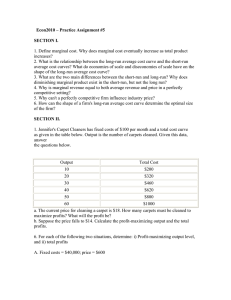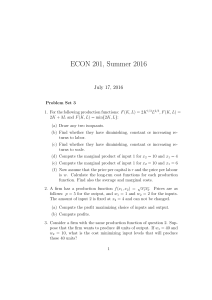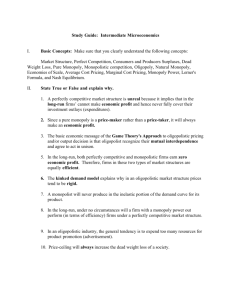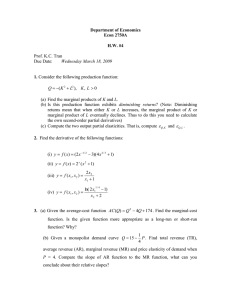Market Structures Quiz: Perfect Competition, Monopoly, Oligopoly
advertisement
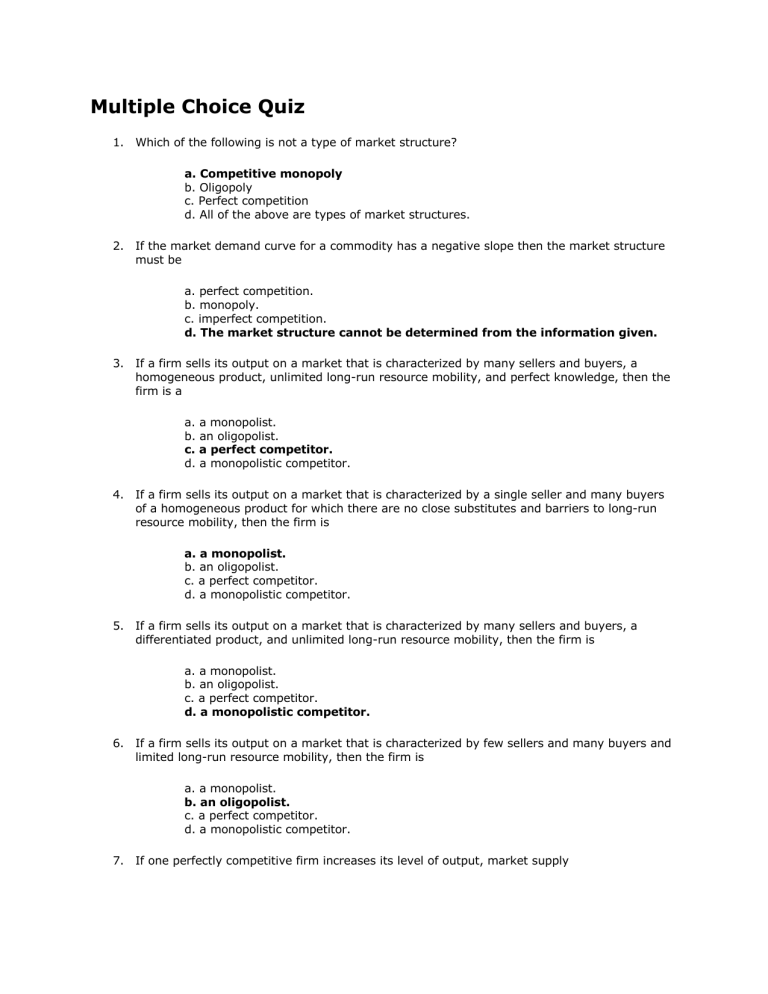
Multiple Choice Quiz 1. Which of the following is not a type of market structure? a. Competitive monopoly b. Oligopoly c. Perfect competition d. All of the above are types of market structures. 2. If the market demand curve for a commodity has a negative slope then the market structure must be a. perfect competition. b. monopoly. c. imperfect competition. d. The market structure cannot be determined from the information given. 3. If a firm sells its output on a market that is characterized by many sellers and buyers, a homogeneous product, unlimited long-run resource mobility, and perfect knowledge, then the firm is a a. a monopolist. b. an oligopolist. c. a perfect competitor. d. a monopolistic competitor. 4. If a firm sells its output on a market that is characterized by a single seller and many buyers of a homogeneous product for which there are no close substitutes and barriers to long-run resource mobility, then the firm is a. a monopolist. b. an oligopolist. c. a perfect competitor. d. a monopolistic competitor. 5. If a firm sells its output on a market that is characterized by many sellers and buyers, a differentiated product, and unlimited long-run resource mobility, then the firm is a. a monopolist. b. an oligopolist. c. a perfect competitor. d. a monopolistic competitor. 6. If a firm sells its output on a market that is characterized by few sellers and many buyers and limited long-run resource mobility, then the firm is a. a monopolist. b. an oligopolist. c. a perfect competitor. d. a monopolistic competitor. 7. If one perfectly competitive firm increases its level of output, market supply a. will increase and market price will fall. b. will increase and market price will rise. c. and market price will both remain constant. d. will decrease and market price will rise. 8. Which of the following markets comes close to satisfying the assumptions of a perfectly competitive market structure? a. The stock market. b. The market for agricultural commodities such as wheat or corn. c. The market for petroleum and natural gas. d. All of the above come close to satisfying the assumptions of perfect competition. 9. A perfectly competitive firm should reduce output or shut down in the short run if market price is equal to marginal cost and price is a. greater than average total cost. b. less than average total cost. c. greater than average variable cost. d. less than average variable cost. 10. The market demand curve for a perfectly competitive industry is QD = 12 - 2P. The market supply curve is QS = 3 + P. The market will be in equilibrium if a. P = 6 and Q = 9. b. P = 5 and Q = 2. c. P = 4 and Q = 4. d. P = 3 and Q = 6. 11. Which of the following is a barrier to entry that typically results in monopoly? a. The firm controls the entire supply of a raw material. b. Production of the industry's product is subject to economies of scale over a broad range of output. c. Production of the industry's product requires a large initial capital investment. d. The firm holds an exclusive government franchise. 12. In the short run, a monopolist will shut down if it is producing a level of output where marginal revenue is equal to short-run marginal cost and price is a. greater than average total cost. b. less than average total cost. c. greater than average variable cost. d. less than average variable cost. 13. A natural monopoly refers to a monopoly that is defended from direct competition by a. economies of scale over a broad range of output. b. a government franchise. c. control over a vital input. d. a patent or copyright. 14. When a perfectly competitive industry is in long-run equilibrium, all firms in the industry a. earn zero economic profits. b. produce a level of output where short-run marginal cost is equal to short-run average total cost. c. produce a level of output where long-run marginal cost is equal to long-run average cost. d. All of the above are correct. 15. The short-run supply curve of a perfectly competitive firm a. is equal to that portion of the short-run marginal cost curve that is above the average variable cost curve. b. is equal to that portion of the short-run marginal cost curve that is above the average total cost curve. c. is equal to that portion of the short-run average total cost curve that is above the average variable cost curve. d. None of the above is correct. 16. The long-run supply curve of a perfectly competitive firm a. is equal to that portion of the long-run marginal cost curve that is above the relevant short-run average variable cost curve. b. is equal to that portion of the long-run marginal cost curve that is above the relevant short-run average total cost curve. c. is equal to that portion of the long-run average total cost curve that is above the relevant short-run average variable cost curve. d. None of the above is correct. 17. A depreciation of the U.S. dollar relative to foreign currencies will make a. foreign imports less expensive in the United States. b. U.S. exports less expensive in foreign countries. c. the demand for U.S. exports decrease. d. All of the above are correct. 18. The value of the U.S. dollar on the foreign exchange market will tend to a. increase if there is an increase in the demand for U.S. exports by foreign countries. b. decrease if there is an increase in the demand for foreign imports by the United States. c. decrease if monetary authorities intervene on the foreign exchange market by selling U.S. dollars for foreign currencies. d. All of the above are correct. 19. A monopolized market is in long-run equilibrium when a. zero economic profit is earned by the monopolist. b. production takes place where price is equal to long-run marginal cost and long-run average cost. c. production takes place where long-run marginal cost is equal to marginal revenue and price is not below long-run average cost. d. All of the above are correct. 20. A monopolist produces 14,000 units of output and charges $14 per unit. Its marginal revenue is $8, its marginal cost is $7 and rising, its average total cost is $10, and its average variable cost is $9. The monopolist should a. increase output, which will result in an increase in the firm's positive economic profit. b. increase output, which will reduce the firm's economic losses. c. shut down, which will reduce the firm's economic losses. d. decrease output, which will result in an increase in the firm's positive economic profit. 21. Which of the following types of firms is likely to be a monopolistic competitor? a. A local telephone company. b. An automobile manufacturer. c. A restaurant. d. All of the above are likely to be monopolistic competitors. 22. Which of the following is a differentiated product? a. A hamburger. b. A shirt. c. An automobile. d. All of the above are differentiated products. 23. Which of the following is a characteristic of monopolistic competition? a. Few sellers. b. A differentiated product. c. Easy entry into and exit from the industry. d. All of the above are characteristics of monopolistic competition. 24. The demand curve faced by a monopolistically competitive firm is a. perfectly elastic. b. elastic. c. unit elastic. d. inelastic. 25. If an imperfectly competitive firm is producing a level of output where marginal cost is equal to marginal revenue, marginal revenue is below average variable cost, and price is equal to average total cost, then the firm a. should shut down. b. should decrease output, but should not shut down. c. should increase output. d. None of the above is correct. 26. If an imperfectly competitive firm is producing a level of output where marginal cost is equal to marginal revenue, marginal revenue is below average variable cost, and price is equal to average total cost, then the firm is a. in long-run equilibrium. b. in short-run equilibrium. c. minimizing short-run average total cost. d. breaking even. 27. Product variation refers to a. an activity undertaken by a firm to increase demand. b. a problem with quality control that tends to decrease demand. c. an activity undertaken by a firm to make demand more price inelastic. d. None of the above is correct. 28. Which of the following is a criticism of the theory of monopolistic competition? a. It is difficult to define a monopolistically competitive market and to determine the firms and products that comprise it. b. When product differentiation is slight, each firm's demand curve is nearly horizontal so the perfectly competitive solution provides an adequate approximation to the monopolistically competitive solution. c. When there are strong brand preferences and few producers of many differentiated products, or when there are many producers but only a few compete as rivals for any given consumer, then the oligopoly solution provides an adequate approximation to the monopolistically competitive solution. d. All of the above are correct. 29. Which of the following industries is most likely to be monopolistically competitive? a. The automobile industry b. The steel industry c. The car repair industry d. The electrical generating industry 30. Marginal revenue is equal to price for which one of the following types of market structure? a. Monopoly b. Perfect competition c. Monopolistic competition d. Oligopoly
